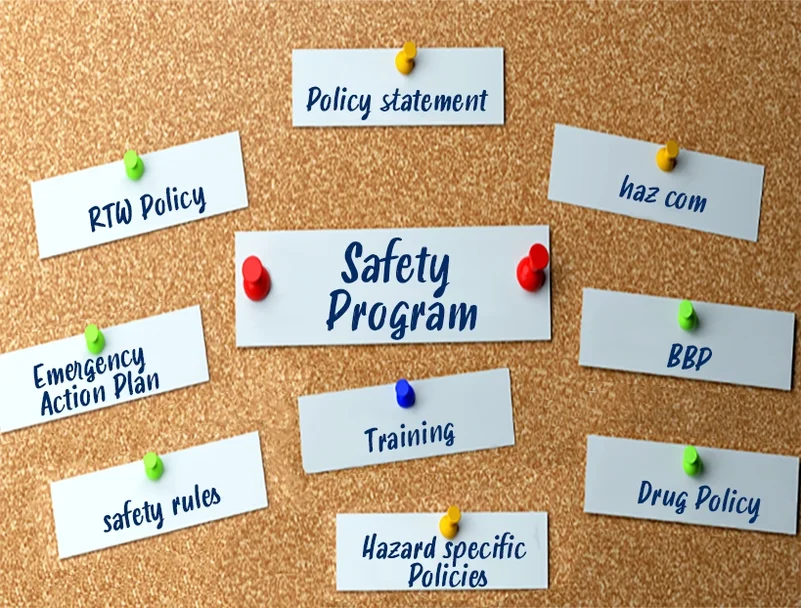No matter the industry, every small business needs to keep its people safe. Yet, developing an effective written safety program often seems complex with its blend of legal mandates, best practices, and various standards, including UL, FM, ISO, OSHA, NFPA, and ANSI, to name a few. Don’t worry. We will walk you through all the essential components of a safety program.
1. Policy Statement
Your safety policy statement should be at the beginning part of your safety program. It demonstrates your commitment to maintaining a safe and healthy work environment. The statement should clearly define the objectives and responsibilities for safety and health, whether that’s the responsibility of management, supervisors, or employees. In short, it says what you aim to do and who needs to do it. It also reminds everyone how important safety is in your organization and your ongoing commitment to continuously improve.
2. Emergency Action Plan (EAP)
An emergency action plan (EAP) is essential to every safety program and your playbook for what to do when things go wrong. Your EAP is a written document detailing the actions employees should take in case of an emergency. It should cover fire, severe weather, chemical spills, or other workplace hazards. Your EAP should include the following: • Evacuation procedures. • Emergency escape routes. • Procedures for accounting for all employees after evacuation. • Medical duties. • Names or job titles of employees to contact in case of an emergency.
3. Safety Rules and Disciplinary Procedures
Your safety program You must also outline the company’s safety rules and the consequences if someone breaks them. The rules should cover general safety practices relevant to your workplace, and disciplinary procedures will ensure consistent enforcement throughout the organization.
4. Hazard Communication
Hazard communication is all about letting your team know what dangerous chemicals they will work with. Train them on the specific dangers so they know how to handle chemicals safely. Also, outline how often training will be required. Your safety program should include the following: • An inventory of all hazardous substances. • Safety data sheets (SDS) for each. • Labeling. • Employee training schedule.
5. Bloodborne Pathogens (BBP)
If your team could come into contact with blood or other bodily fluids (for any reason), you need a BBP plan. Let me translate. This means almost everyone should have one in place. This plan will outline the risks, how to avoid them, and what to do after exposure.
6. Return-to-Work Policy
A return-to-work policy should be in place to support employees returning to work after a work-related injury or illness. This program will help them return to work, even if they need to do light or alternative duties. It also ensures they’re healthy enough to work again and receive the required medical clearance to return to full duty. We have an article specifically on return to work, which you can find here. (https://smarterrisk.com/english/blog/five-steps-to-reduce-workers-compensation-costs/)
7. Drug and Alcohol Policy
A drug and alcohol policy outlines your business’s stance on substance use in the workplace. It should explain when to test for substances, what happens if someone fails a drug test, and where employees can get help.
8. Hazard-Specific Policies
Hazard-specific policies should be developed when applicable, for example, working at heights, confined spaces, trenching, electrical safety, lock-out tag-out, respiratory protection, ergonomics and manual material handling, slip and fall, overhead cranes, hand power tools, mobile elevated work platforms, and personal protective equipment (PPE). The goal is to identify potential dangers, establish preventative measures, and outline what to do if something goes wrong.
Conduct a hazard assessment for each job to identify potential risks. From there, develop the necessary policies, including appropriate PPE, safe work practices, training requirements, and emergency response protocols. Each policy should be tailored to your workplace and the specific hazards your employees may encounter.
9. Safety Training Program
Training is a big part of your safety program. Everyone should understand the safety program and the risks they might face in their jobs. You should also require refresher training annually or whenever a significant change in the work environment or procedures occurs.
Conclusion
So, putting together a safety program takes some thought and care. But it’s worth it - you will prevent accidents, potentially steer clear of OSHA violations, and qualify for better insurance rates. Plus, you’ll know you’re doing everything possible to keep your team safe, and that’s good for business. Once you have your safety program, you’ll need to implement it in your business. We have a blog post detailing how to execute your safety program. (https://smarterrisk.com/english/blog/implementing-safety-and-risk-control-programs/)
Are you feeling overwhelmed? We get it– making a safety program can feel like a big task. But we have the tools to make it a lot easier! Our platform is designed to automate the creation of safety and risk control programs. Our tools include a free initial assessment to evaluate your current safety measures and a policy builder tool so that you can develop programs in minutes, not months. Sign up at https://smarterrisk.com.


